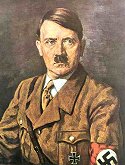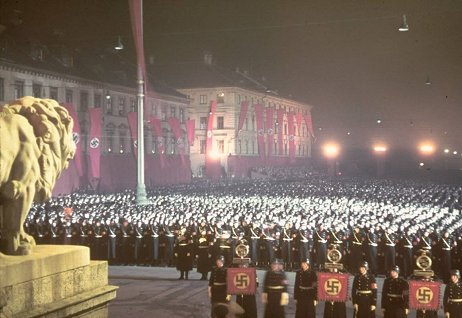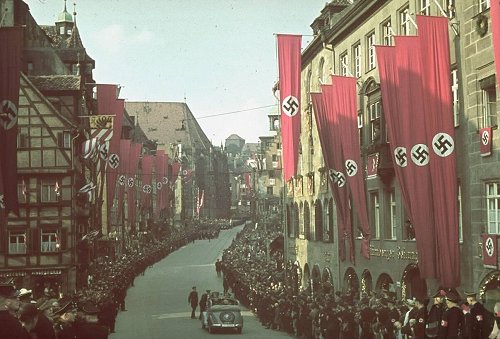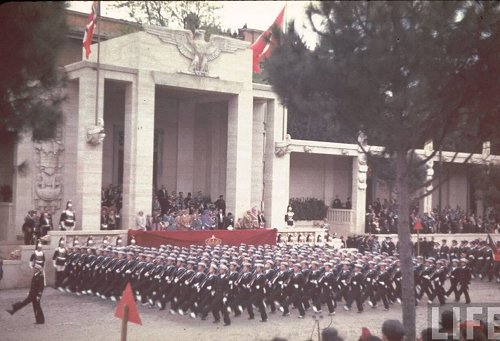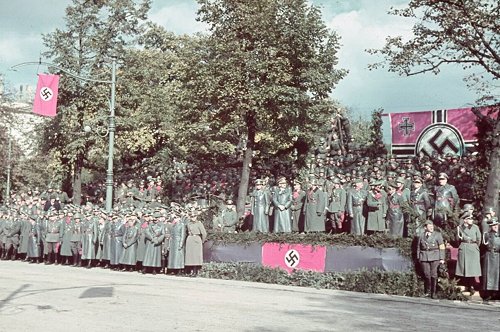Axis Powers
The Nazi revolution occurred in 1933, not through a coup but by democratic means. By co-opting the Reichstag and intimidating opposition polititicans into silence, Adolph Hitler turned himself into an elected dictator through the passing of the "Enabling Act". This allowed him to rule by decree and over the next six years his National Socialist party consolidated their grip on power. Hitler merged the offices of Chancellor and President and became known as the Fuhrer (leader). The Nazis envisioned a new Germanic Reich (empire) to rule over Europe, a new Holy Roman Empire, the Third Germanic Reich.
To key to this vision was the Nazi's race ideology. The Aryan people were seen as the rightful owners of the Germanic lands, and so the Nazis began to marginalise non-Germanic elements. This included people who were non-German by genetics, such as the Slavs and the Jews, as well as non-Germanic in thought, such as homosexuals, Communists and the mentally handicapped. Germanic folk culture was promoted and conservative values such as a strong family and women staying at home were rewarded. As well as this the Nazis sought a strong and healthy population with bans on public smoking and a mandatory break at the start of the work day for group calisthenics.
The Nazis exaulted manual labour, and with the country reeling from the effects of the Great Depression, they has access to a huge workforce to use in state mega-projects. These included the now famous Auto-Bahns, and large scale land drainage projects. Hitler was acutely worried about a Royal Navy blockade crippling his new Third Reich just like it had crippled the Second Reich under Kaiser Wilhelm II. Thus the country was made self-sufficient as far as was possible in terms of food and raw materials, while new ties to eastern Europe securred favourable trade agreements for what was not availible domestically.
Of course the Imperialistic ambitions of the Nazis stretch far beyond their current borders. For the past six years the Nazis have been funnelling an increasing percentage of their national budget into the military. The Versailles Treaty places strict limits on the size of the German army and what kind of machinery it can operate. However using a mix of subterfuge and outright flouting of the rules the Nazis have expanded the Luftwaffe and Panzer corps into formiddable weapons. The treaty, by limiting manpower, forced the Germans to push for an extreme level of professionalism and elan from their soliders. Drawing on Prussian military heritage and being compelled to select only the best candidates, the German Defence Force, the Whermacht, is a very elite force.
While victories in the Great War entrenched a decorated old guard in the Allied powers, the Whermacht was force to re-evaluate itself. New thinkers such as Heinz Guderian have pioneered a new form of mechanised warfare. Taking elements of old manouver warfare cavalry tactics and matching them with modern trucks, APCs, tanks and aircraft Guderian proposed a new philosophy of warfare that forms the cornerstone of the Third Reich's strategic thinking. The idea is to use massed tanks to blast through enemy front lines, but instead of wheeling back around to envelop their soldiers, these troops would continue to press into enemy territory, bypassing resistence and attacking the enemies control posts, supply areas and other essential soft targets that allow a modern army to fight. These rapid advances would require mobile infantry divisions that could keep pace with the Panzers. Thus APCs and trucks were just as important to Blitzkrieg as the Panzers. Towed guns and mounted infantry simply dropped horses for vehicles and rode behind their armoured spearheads. Meanwhile, aircraft would interdict enemy logstics and provide a flying artillery service for troops on the front line sowing confusion and mayhem.

